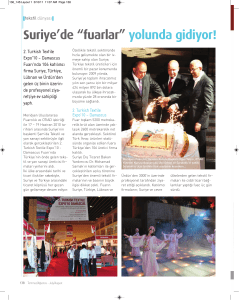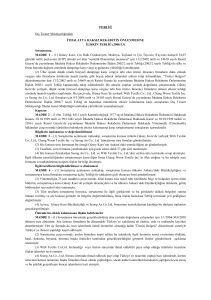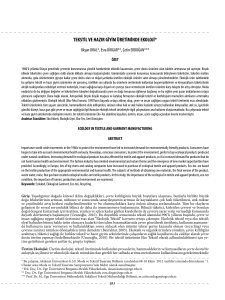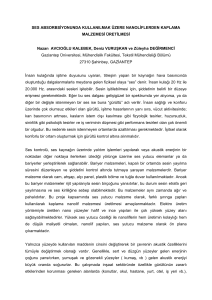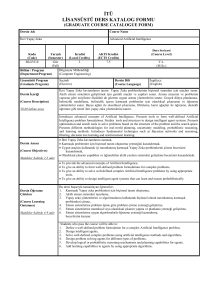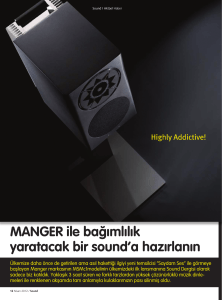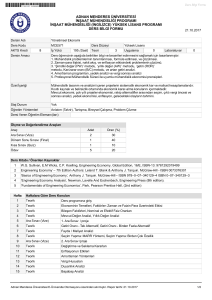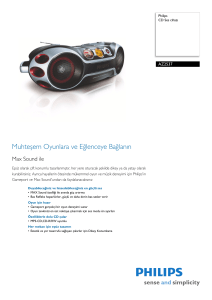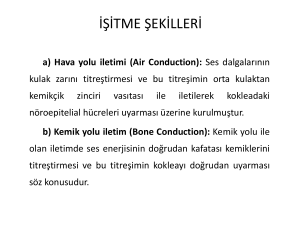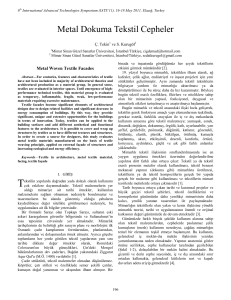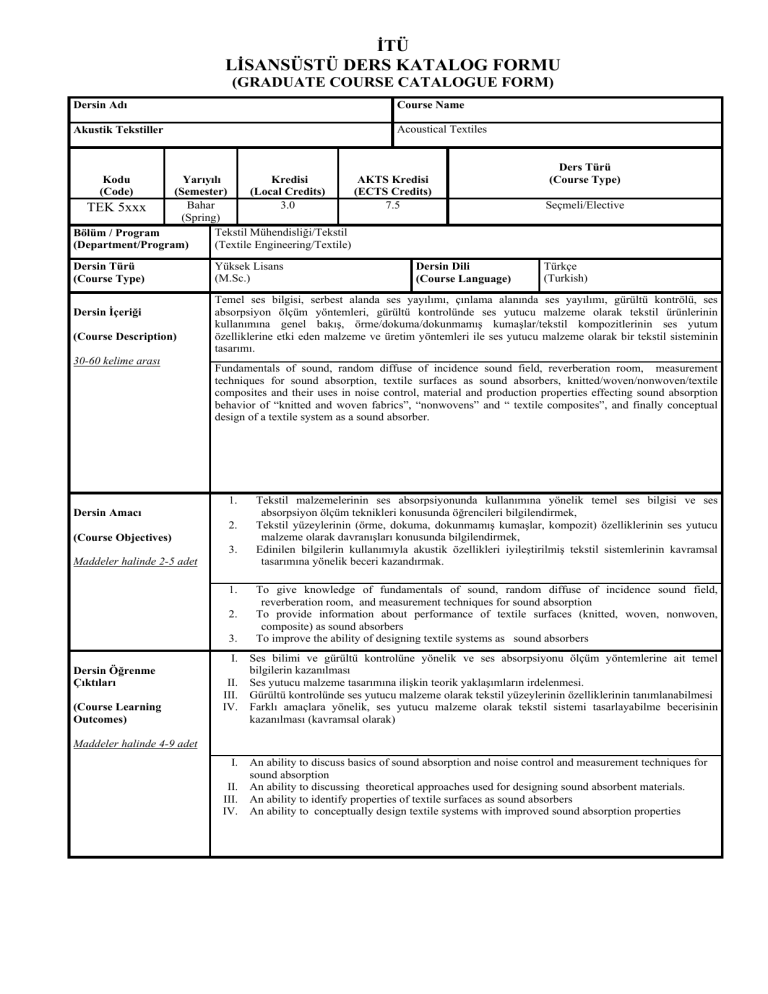
İTÜ
LİSANSÜSTÜ DERS KATALOG FORMU
(GRADUATE COURSE CATALOGUE FORM)
Dersin Adı
Course Name
Akustik Tekstiller
Acoustical Textiles
Kodu
(Code)
Yarıyılı
Kredisi
AKTS Kredisi
(Semester)
(Local Credits)
(ECTS Credits)
Bahar
3.0
7.5
TEK 5xxx
(Spring)
Tekstil Mühendisliği/Tekstil
Bölüm / Program
(Textile Engineering/Textile)
(Department/Program)
Dersin Türü
(Course Type)
Dersin İçeriği
(Course Description)
30-60 kelime arası
Yüksek Lisans
(M.Sc.)
Türkçe
(Turkish)
Fundamentals of sound, random diffuse of incidence sound field, reverberation room, measurement
techniques for sound absorption, textile surfaces as sound absorbers, knitted/woven/nonwoven/textile
composites and their uses in noise control, material and production properties effecting sound absorption
behavior of “knitted and woven fabrics”, “nonwovens” and “ textile composites”, and finally conceptual
design of a textile system as a sound absorber.
1.
2.
(Course Objectives)
3.
Maddeler halinde 2-5 adet
1.
2.
3.
(Course Learning
Outcomes)
Seçmeli/Elective
Temel ses bilgisi, serbest alanda ses yayılımı, çınlama alanında ses yayılımı, gürültü kontrölü, ses
absorpsiyon ölçüm yöntemleri, gürültü kontrolünde ses yutucu malzeme olarak tekstil ürünlerinin
kullanımına genel bakış, örme/dokuma/dokunmamış kumaşlar/tekstil kompozitlerinin ses yutum
özelliklerine etki eden malzeme ve üretim yöntemleri ile ses yutucu malzeme olarak bir tekstil sisteminin
tasarımı.
Dersin Amacı
Dersin Öğrenme
Çıktıları
Dersin Dili
(Course Language)
Ders Türü
(Course Type)
Tekstil malzemelerinin ses absorpsiyonunda kullanımına yönelik temel ses bilgisi ve ses
absorpsiyon ölçüm teknikleri konusunda öğrencileri bilgilendirmek,
Tekstil yüzeylerinin (örme, dokuma, dokunmamış kumaşlar, kompozit) özelliklerinin ses yutucu
malzeme olarak davranışları konusunda bilgilendirmek,
Edinilen bilgilerin kullanımıyla akustik özellikleri iyileştirilmiş tekstil sistemlerinin kavramsal
tasarımına yönelik beceri kazandırmak.
To give knowledge of fundamentals of sound, random diffuse of incidence sound field,
reverberation room, and measurement techniques for sound absorption
To provide information about performance of textile surfaces (knitted, woven, nonwoven,
composite) as sound absorbers
To improve the ability of designing textile systems as sound absorbers
I. Ses bilimi ve gürültü kontrolüne yönelik ve ses absorpsiyonu ölçüm yöntemlerine ait temel
bilgilerin kazanılması
II. Ses yutucu malzeme tasarımına ilişkin teorik yaklaşımların irdelenmesi.
III. Gürültü kontrolünde ses yutucu malzeme olarak tekstil yüzeylerinin özelliklerinin tanımlanabilmesi
IV. Farklı amaçlara yönelik, ses yutucu malzeme olarak tekstil sistemi tasarlayabilme becerisinin
kazanılması (kavramsal olarak)
Maddeler halinde 4-9 adet
I. An ability to discuss basics of sound absorption and noise control and measurement techniques for
sound absorption
II. An ability to discussing theoretical approaches used for designing sound absorbent materials.
III. An ability to identify properties of textile surfaces as sound absorbers
IV. An ability to conceptually design textile systems with improved sound absorption properties
Ders Kitabı ve diğer
kaynaklar
(Textbook and Other
References)
Maddeler halinde en çok 5 adet
1.
2.
3.
4.
5.
Ödevler ve Projeler
(Homework & Projects)
Özgüven H.N., (2008). Gürültü Kontrolü, Endüstriyel ve Çevresel Gürültü, Türk
Akustik Derneği, Ankara
Kinsler L.E., (2000). Fundamentals of Acoustics, John Wiley & Sons Inc.,
Tilak D., Ravindra M., (2006). Sound Absorption in Knitted Structure for Interior
Noise Reduction in Automobiles, Meas. Sci. Technol. 17
Parikh D.V., Chen Y., Sun L., (2009). Reducing Automotive Interior Noise with
Natural Fiber Non-woven Floor Covering Systems, Textile Research Journal, 76(11) 8
Tascan M., Vaughn E.A., (2008). Effects of Total Surface Area and Fabric Density on
the Acoustical Behavior of Needlepunched Nonwoven Fabrics, Textile Research
Journal, 78(4)
Öğrencilerin dersi daha iyi öğrenmelerine yardımcı olmak amacı ile dönem boyunca 6 ödev ve
1 dönem ödevi ders konularına uygun konular verilmektedir. Tüm ödevler ve dönem ödevi
rapor halinde hazırlanıp sunulmaktadır.
Six homework and one term paper will be prepared by students. All homework and term paper
will be prepared and presented as a formal report.
Laboratuar Uygulamaları
(Laboratory Work)
Bilgisayar Kullanımı
(Computer Use)
Diğer Uygulamalar
(Other Activities)
Başarı Değerlendirme
Sistemi
(Assessment Criteria)
Faaliyetler
(Activities)
Yıl İçi Sınavları
(Midterm Exams)
Kısa Sınavlar
(Quizzes)
Ödevler
(Homework)
Projeler
(Projects)
Dönem Ödevi/Projesi
(Term Paper/Project)
Laboratuar Uygulaması
(Laboratory Work)
Diğer Uygulamalar
(Other Activities)
Final Sınavı
(Final Exam)
Adedi*
(Quantity)
1
Değerlendirmedeki Katkısı, %
(Effects on Grading, %)
% 15
(15 %)
6
% 30
(30 %)
1
%15
(15 %)
1
% 40
(40 %)
*Yukarıda Belirtilen Sayılar Minimum Olup Yerine Getirilmesi Zorunludur.
DERS PLANI
Hafta
1
2
3
4
5
6
7
8
9
10
11
12
13
14
Konular
Temel ses bilgisi
Serbest alanda ve çınlama alanında ses yayılımı
Gürültü kontrölü ve ses absorpsiyon ölçüm yöntemleri
Gürültü kontrolünde ses yutucu malzeme olarak tekstil ürünlerinin kullanımına genel bakış
Ses yutucu malzeme tasarımında kullanılan teorik yaklaşımlar: Yapısı homojen kabul edilen
malzemeler için geliştirilmiş modeller.
Ses yutucu malzeme tasarımında kullanılan teorik yaklaşımlar: Kapiler gözenek ve amprik
modeller.
Ses yutucu malzeme olarak örme kumaş yapıları: farklı malzemelerden mamul yaygın örme
kumaş yapılarının (tek ve çift plaka standart örgüler) ses yutum özellikleri
Ses yutucu malzeme olarak örme kumaş yapıları: farklı malzemelerden mamul sandviç yapılı
örme kumaşların ses yutum özellikleri
Ses yutucu malzeme olarak dokuma kumaş yapıları: farklı malzemelerden mamul, ev tekstiline
yönelik (yer ve duvar kaplamaları, döşemelikler) dokuma kumaş yapılarının ses yutum özellikleri
Ses yutucu malzeme olarak dokusuz yüzey: farklı malzeme kullanımının ses yutum özelliklerine
etkisi
Ses yutucu malzeme olarak dokusuz yüzey: farklı üretim yöntemlerinin ses yutum özelliklerine
etkisi
Ses yutucu malzeme olarak tekstil kompozitleri
Akustik özellikleri iyileştirilmiş, ev tekstiline yönelik bir tekstil sisteminin kavramsal tasarımı
Akustik özellikleri iyileştirilmiş, otomotiv sektörüne yönelik bir tekstil sisteminin kavramsal
tasarımı
Dersin
Çıktıları
I
I
I
III, IV
II
II
III, IV
III, IV
III, IV
III, IV
III, IV
III, IV
IV
IV
COURSE PLAN
Weeks
1
2
3
4
5
6
7
8
9
10
11
12
13
14
Topics
Fundamentals of Sound
Random diffuse of incidence sound field, reverberation room
Noise control and measurement techniques for sound absorption
Introduction to textile surfaces as sound absorbers
Theoretical approaches used in designing sound absorbant materials: Quasi homogeneous
material model
Theoretical approaches used in designing sound absorbant materials: Capillary pore models
and empirical models
Knitted fabric structures as sound absorbers:performance of conventional knitted fabric
structures (single and double jersey) from different materials in terms of sound absorbency
Knitted fabric structures as sound absorbers:performance of spacer knitted fabric structures
from different materials in terms of sound absorbency
Woven fabric structures as sound absorbers:performance of woven fabric structures used in
home textiles (floor and wall coverings, furnishing materials) from different materials in terms
of sound absorbency
Nonwoven fabrics as sound absorbers: performance of nonwovens from different materials
Nonwoven fabrics as sound absorbers: performance of nonwovens produced by different
techniques
Textile composites as sound absorbers
Conceptual designing of textile systems for home textiles with improved acoustical properties
Conceptual designing of textile systems for automotive sector with improved acoustical
properties
Course
Outcomes
I
I
I
III, IV
II
II
III, IV
III, IV
III, IV
III, IV
III, IV
III, IV
IV
IV
Dersin Tekstil Mühendisliği Programıyla İlişkisi
Programın mezuna kazandıracağı bilgi, beceri ve yetkinlikler (programa ait çıktılar)
i.
ii.
iii.
iv.
v.
vi.
vii.
Lisans düzeyi yeterliliklerine dayalı olarak, tekstil mühendisliği alanında bilgilerini uzmanlık
düzeyinde geliştirebilme ve derinleştirebilme (yeterli bilgi birikimi) (bilgi).
Tekstil mühendisliğinin ilişkili olduğu disiplinler arası etkileşimi kavrayabilme (bilgi).
Tekstil mühendisliği alanında edindiği uzmanlık düzeyindeki kuramsal ve uygulamalı bilgileri
kullanabilme (beceri).
Tekstil mühendisliği alanında edindiği bilgileri farklı disiplin alanlarından gelen bilgilerle
bütünleştirerek yorumlayabilme ve yeni bilgiler oluşturabilme (beceri).
Tekstil mühendisliği ile ilgili karşılaşılan sorunları araştırma yöntemlerini kullanarak
çözümleyebilme (beceri).
Tekstil mühendisliği ile ilgili uzmanlık gerektiren bir çalışmayı bağımsız olarak yürütebilme
(Bağımsız Çalışabilme ve Sorumluluk Alabilme Yetkinliği).
Tekstil mühendisliği ile ilgili uygulamalarda karşılaşılan ve öngörülemeyen karmaşık sorunların
çözümü için yeni stratejik yaklaşımlar geliştirebilme ve sorumluluk alarak çözüm üretebilme
(Bağımsız Çalışabilme ve Sorumluluk Alabilme Yetkinliği).
Katkı
Seviyesi
1
2
3
x
x
x
x
x
x
x
viii.
Tekstil mühendisliği ile ilgili sorunların çözümlenmesini gerektiren ortamlarda liderlik
yapabilme (Bağımsız Çalışabilme ve Sorumluluk Alabilme Yetkinliği).
x
ix.
Tekstil mühendisliği alanında edindiği uzmanlık düzeyindeki bilgi ve becerileri eleştirel bir
yaklaşımla değerlendirebilme ve öğrenmesini yönlendirebilme (Öğrenme Yetkinliği).
Tekstil mühendisliği alanındaki güncel gelişmeleri ve kendi çalışmalarını, nicel ve nitel veriler ile
destekleyerek, alanındaki ve alan dışındaki gruplara, yazılı, sözlü ve görsel olarak sistemli
biçimde aktarabilme (İletişim ve Sosyal Yetkinlik).
Sosyal ilişkileri ve bu ilişkileri yönlendiren normları eleştirel bir bakış açısı ile inceleyebilme,
geliştirebilme ve gerektiğinde değiştirmek üzere harekete geçebilme (İletişim ve Sosyal Yetkinlik).
Bir yabancı dili en az Avrupa Dil Portföyü B2 genel düzeyinde kullanarak sözlü ve yazılı iletişim
kurabilmek (İletişim ve Sosyal Yetkinlik).
Tekstil mühendisliğinin gerektirdiği düzeyde bilgisayar yazılımı ile birlikte bilişim ve iletişim
teknolojilerini ileri düzeyde kullanabilme (İletişim ve Sosyal Yetkinlik).
Tekstil mühendisliği ile ilgili verilerin toplanması, yorumlanması, uygulanması ve duyurulması
aşamalarında toplumsal, bilimsel, kültürel ve etik değerleri gözeterek denetleyebilme ve bu
değerleri öğretebilme (Alana Özgü Yetkinlik).
Tekstil mühendisliği ile ilgili konularda strateji, politika ve uygulama planları geliştirebilme ve
elde edilen sonuçları, kalite süreçleri çerçevesinde değerlendirebilme (Alana Özgü Yetkinlik).
Tekstil mühendisliğinde özümsedikleri bilgiyi, problem çözme ve/veya uygulama becerilerini,
disiplinlerarası çalışmalarda kullanabilme (Alana Özgü Yetkinlik).
Tekstil mühendisliği alanındaki uluslararası platformlarda, kendi çalışmalarını yazılı, sözlü
ve/veya görsel olarak aktarabilme (Alana Özgü yetkinlik).
x
x.
xi.
xii.
xiii.
xiv.
xv.
xvi.
xvii.
1: Az, 2. Kısmi, 3. Tam
x
x
x
x
x
x
x
x
Relationship between the Course and Textile Engineering Curriculum
Level of
Contribution
1
2
3
Program Outcomes
i.
ii.
iii.
iv.
v.
vi.
vii.
viii.
ix.
x.
xi.
xii.
xiii.
xiv.
xv.
xvi.
xvii.
Developing and intensifying knowledge in the textile engineering area, based upon the
competency in the undergraduate level (sufficient knowledge) (knowledge).
Grasping the inter-disciplinary interaction related to textile engineering (knowledge).
The ability to use the expert-level theoretical and practical knowledge acquired in textile
engineering area (skill).
Interpreting and forming new types of knowledge by combining the knowledge from the textile
engineering area and the knowledge from various other disciplines (skill).
Solving the problems faced in textile engineering area by making use of the research methods
(skill).
The ability to carry out a specialistic study related to textile engineering area independently
(Competence to work independently and take responsibility).
Developing new strategic approaches to solve the unforeseen and complex problems arising in
the practical processes of textile engineering area and coming up with solutions while taking
responsibility (Competence to work independently and take responsibility).
Fulfilling the leader role in the environments where solutions are sought for the problems
related to textile engineering area (Competence to work independently and take responsibility).
Assessing the specialistic knowledge and skill gained through the textile engineering study
with a critical view and directing one’s own learning process (Learning Competence).
Systematically transferring the current developments in textile engineering area and one’s own
work to other groups in and out of the area; in written, oral and visual forms (Communication
and Social Competency).
Ability to see and develop social relationships and the norms directing these relationships with
a critical look and the ability to take action to change these when necessary (Communication
and Social Competency).
Proficiency in a foreign language –at least European Language Portfolio B2 Level- and
establishing written and oral communication with that language (Communication and Social
Competency).
Using the computer software together with the information and communication technologies
efficiently and according to the needs of the textile engineering area (Communication and
Social Competency).
Paying regard to social, scientific, cultural and ethical values during the collecting, interpreting,
practicing and announcing processes of the textile engineering area related data and the ability
to teach these values to others (Area Specific Competency).
Developing strategy, policy and application plans concerning the subjects related to textile
engineering area and the ability to evaluate the end results of these plans within the frame of
quality processes (Area Specific Competency).
Using the knowledge and the skills for problem solving and/or application (which are
processed within textile engineering) in inter-disciplinary studies (Area Specific Competency).
The ability to present one’s own work within the international environments in textile
engineering area, orally, visually and in written forms (Area Specific Competency).
x
x
x
x
x
x
x
x
x
x
x
x
x
x
x
x
x
1: Little, 2. Partial, 3. Full
Düzenleyen (Prepared by)
Prof.Dr. Banu U. Nergis & Prof.Dr.
Cevza Candan
Tarih (Date)
14.11.2011
İmza (Signature)

